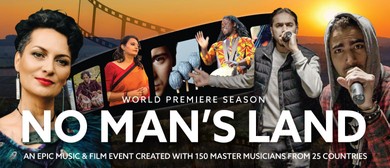"A Hugely inspiring piece - Dazzling!"
To date a fair amount of Great War commemorative project shave focussed on the ANZAC experience. But John Psathas' work, No Man's Land, is initially different an considerably more inclusive of the participation and scale of the event. Back in January John told me that it was the intention of himself and his co-collaborators to capture many different cultural perspectives and stories. "80% of the world's population was involved in WWI. There are so many everyday stories from other ethnicities: Turkish, Polish, Armenian, Russian, Belgian, Greek, Indian. So we decided to move away from 'Euro-centric' stories...chose places that aren't as well covered, like Poland, for example - so ravaged by the war. We filmed on the Ukraine border; on the Somme, Passchendaele, Belgium."
 |
| John Psathas |
The technical scale of the production tonight was also quite astounding. A small deft orchestra of drums, zither, strings, guitar and keys surrounded by a massive screen and a series of seven pod screens that fade in and out distant individual musicians like ghosts to play alongside the live and present crew. They in turn play alongside a montage of drummers, keyboardists, guitarists, a bagpiper and many more who have been filmed individually or together on the battle field sites of Europe and in India and Turkey. Editing is so seamless, between the co-ordination of the stage musicians and those on film that it's almost impossible to differentiate between recorded and live.
Part of the project's scope was to find stories of everyday people, affected by the Great War. Women's stories, for example, are represented by series of singers - Ariana Tikau (NZ); Oum (Morroco/France); Meeta Pandit (India); Hungarian Márta Sebestyén (who sung in the "The English Patient") and Jolanta Kossakowska (Poland). "All from very different cultures but singing this continuous song, handing it over to each other as we move across a No Man's Land...singing to their beloved across the distance...from all the sweethearts, mothers, sisters who were left behind across the world - sometimes forever." This comes in their song and in a short clip of children walking across Waikanae beach, interspersed with another clip of SerjTankin singing on the top of a Turkish beach head, somewhere near the ANZAC cove. It's amazing how similar the terrain is.
Sebestyén features prominently in the show, playing violin and singing, sometimes in a whisper, sometimes screaming or echoing the voices on the screens. Meeta Pandit sits on her left, playing a lap steel harp, with beautiful harmonies entwining with the many layers of sound..
Psathas's music builds on swirling and chanting chorus with the same attack and release method used successfully by club land DJ's - especially those from the Ministry of Sound and Renaissance school popular in the 1990's from Brixton to Ibiza. He might be classically trained but that's only the start of his platform - more a guide to how things work. Moreover, his Mediterranean background and his collaborations with Tankin provide the strongest themes to his compositions. Sure, it's world music, but centred and focussed. My friend thought it sounded a little like Pink Floyd, Alan Parsons or Danny Elfman but to put a finger on the exact reference points would simply do a disservice.
The footage, by Jasmine Millett is stunning. Many walk-throughs of the original tunnels, some still in tact, interspersed with photos of the events that happened. And an interesting after shot of each: before - a ravaged wasteland' and now - dense, greenery and creepers, slowly reclaiming the devastation and repairing the scars from 100 year's earlier.
On the whole, this work was dazzling. To have met John and seen his vision made live was a real privileged and I totally got in to it. My friend needed a little coaxing and more info. Perhaps a title or two? Or a hidden sign or other clues to help us along. And what an opportunity to bring in new voices and sounds. But that's a minor point. The real shame is that this is only a one off. Hopefully crowds at WOMAD and The Auckland Festival will also appreciate this as much as tonight's audience did. We were all on our feet, at the end, wiping back tears and smiling from ear to ear.
Listen to the Coffeebar Kid interview with John Psathas.
Visit the festival site: http://www.festival.co.nz/2016/events/no-mans-land/










No comments:
Post a Comment